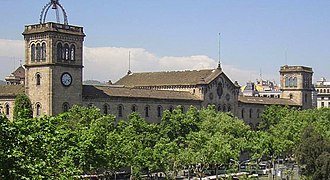Elies Rogent
Elies Rogent i Amat (born July 6, 1821 in Barcelona , † February 21, 1897 in Barcelona) was a Catalan architect and an important pioneer of modernism .
Initially, Rogent attended the architecture class of the Escola de la Llotja in Barcelona before moving to the architecture school in Madrid , where he graduated in 1848. As an admirer of Eugène Viollet-le-Duc , he developed a keen interest in Gothic and Romanesque architecture and acquired extensive knowledge in these areas on extensive study trips through Catalonia.
From 1871 Rogent was director of the Escola d'Arquitectura de Barcelona . There belonged to his students u. a. Lluís Domènech i Montaner and Antoni Gaudí . About the latter, after graduation, he had said the now famous sentence: "Who knows whether we have given the title to a madman or a genius - only time will tell us."
In 1887, the mayor of Barcelona, Francesc Rius i Taulet, entrusted him with the planning management of the 1888 World's Fair , which was threateningly delayed due to construction errors. He made significant changes to the original concept of Josep Fontserè i Mestre's exhibition and managed to complete the ambitious project in record time for the opening. Inspired by the ideas of the Renaixença , he insisted on only commissioning local architects and building exclusively with traditional materials. As part of his overall planning, the Arc de Triomf ("Triumphal Arch") by Josep Vilaseca i Casanovas and the café-restaurant on the exhibition grounds known as Castell dels Tres Dragons ("Castle of the Three Dragons"), now the Zoological Museum, by Lluís Domènech i Montaner - the first two trend-setting buildings of the Catalan Art Nouveau.
Works
His most important works include:
- 1858 Mataró prison
- 1865 Vallvidrera dam
- 1868 Casa Arnús on Passeig de Gràcia in Barcelona
- 1870 Casa Almirall on Carrer Pelai in Barcelona
- 1873 University of Barcelona
- 1877 Magatzem's Generals at the port of Barcelona
- 1878 Seminari Conciliar in Barcelona
In addition, he led numerous restoration work, including a .:
- 1852 restoration of the cloister of the monastery of Sant Cugat del Vallès
- 1854 restoration of the cloister of the monastery of Santa Maria de Montserrat
- 1886 restoration of the monastery of Santa Maria de Ripoll .
| personal data | |
|---|---|
| SURNAME | Rogent, Elies |
| ALTERNATIVE NAMES | Rogent i Amat, Elies |
| BRIEF DESCRIPTION | Catalan architect |
| DATE OF BIRTH | July 6, 1821 |
| PLACE OF BIRTH | Barcelona |
| DATE OF DEATH | February 21, 1897 |
| Place of death | Barcelona |
